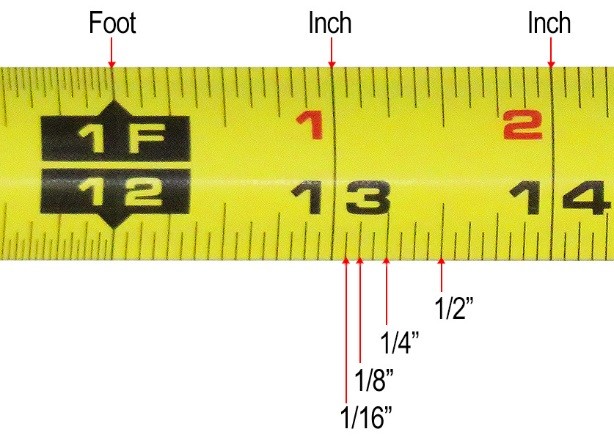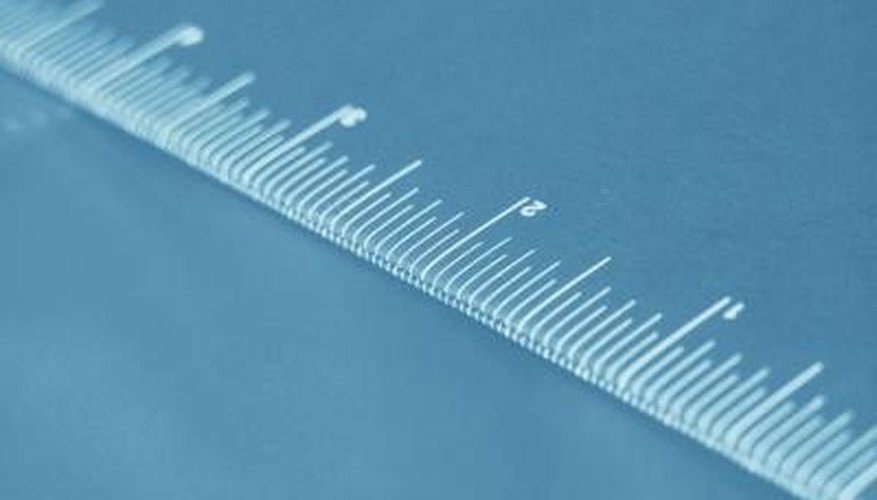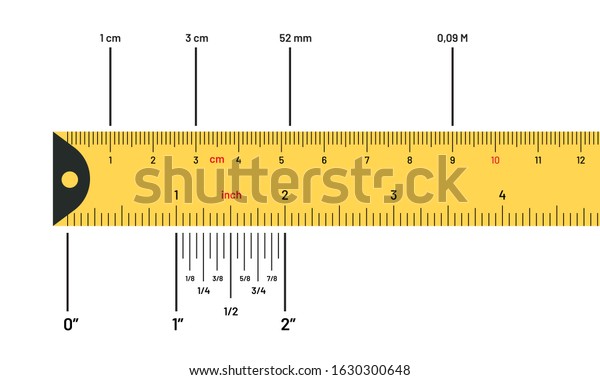Tape measures are often designed for specific uses or trades. Tapes may have different scales, be made of different materials, and be of different lengths depending on the intended use. Tape measures that were intended for use in tailoring or dressmaking were made from flexible cloth or plastic.
These types of tape measures were mainly used for the measuring of the subject's waist line. Today, measuring tapes made for sewing are made of fiberglass, which does not tear or stretch as easily. This type of tape measure will have a floating tang or hook on the end to aid measuring.
A tape measure of 25 or even 100 feet can wind into a relatively small container. The self-marking tape measure allows the user an accurate one hand measure. There are several different ways to read a tape measure, but first, you need to find out what kind of tape measure you have. There are standard, or imperial tape measures, and metric tape measures. Imperial tapes feature inches, while metric tapes measure centimeters and millimeters.
Some models have both imperial and metric measurements. Look for a tape measure that best fits your needs and feels comfortable. But, before we get to reading a tape measure you need to know how to use it. The Series 100 is our premium professional quality tape. We took everything we've learned about tape measures and poured it into this one. The Series 100 has a nylon-coated blade for durability with wide-read numbers and easy-read inch fractions printed throughout its length.
Inches are shown in both consecutive format and as a function of feet. You'll find 1/32″ graduations for the first foot and 1/16″ for the remainder. Flip the blade over and you'll also find vertically-reading metric graduations, with decimeters marked in red. A dual-hooked magnetic endpiece allows you to use either side of the blade to take measurements.
The strong magnetic endpiece adheres securely to metal surfaces, and even gives inch and metric measurements on its two vertical spires. A frontside lock and an underside pause button give effortless tape control while keeping fingers clear of the tape. A substantial rubber jacket with grip-bumps provides shock absorption and secure ergonomics in the hand. Whether you're a tradesman, hobbyist, or general DIYer, this is the tape you will use for years.
We can print your 1-color logo on this tape in quantites as small as 50. No matter which measurement system your measuring tape follows, the basic anatomy of the tool and how to read it remain the same. Reading a tape measure correctly is a necessary skill when taking on DIY projects.
Tape measures are available in both standard or imperial units and in metric units. This guide will show you how to read a tape measure. Plus, you'll learn some tips and tricks for using this tool to get precise measurements. Most standard tape measures in the U.S. have markings that measure down to 1/16 of an inch. These are smaller, sometimes thinner markings, evenly spaced between the half-inch and inch marks on a tape measure.
On some tapes, quarter inch marks are the same size as eighth-inch marks. Remember that two sixteenths of an inch equals one eighth, two eighths of an inch equals one quarter, and 2 quarters equals one half. For example, the second eighth-inch marking after the inch marking is a quarter inch. The Easiest To Read Digital Tape Measure has an LCD screen that makes it faster and easier than ever to get measurements from the tape. Equipped with a large, easy-to-read 1.75" x .75" digital display screen, you won't have to squint to read tiny lines on the tape. It measures standard or metric, showing feet, inches, centimeters, decimals and fractions.
Features 2 memory functions, U.S. and metric units, center line calculation, blade lock and re-zero option. Makes a great gift for the handy man in your life! In some countries such as the UK, tape measures have both Imperial and Metric measurement markings. Until recently in the US, for example, all tape measures were in Imperial units, however the dual standard option is becoming more widely available.
A tape measure, or measuring tape is a type of hand tool typically used to measure distance or size. It is like a much longer flexible ruler consisting of a case, thumb lock, blade/tape, hook, and sometimes a belt clip. A tape measure will have imperial readings, metric readings or both.
They are a common measuring tool used in both professional trades and simply around the home. You will get two nice tape measures in this package from LEXIVON. The case of the tape measure is made of hard ABS plastic with a rubber boot for protection against impact and firm grip. The tape of this tool is wide, 1 inch, and both metric and imperial units are available with easy-to-read fractional markings. It is coated with nylon for protection against wear and tear.
There are many other ways of measuring tapes, but learning how to read a tape measure is the easiest way to accurately determine the measurement. Knowing which units are metric and which units are standard is crucial in making purchasing decisions. Learning the definition of inches, mils, and other measurement units is also important to avoid purchasing products that are incorrectly measured. With these simple tools, individuals can easily learn how to read a tape measure and discover the precise measurement that they need. The dual scale measuring tape CMHT37226S from CRAFTSMAN includes both metric and imperial units. The total length of the tape is 26 feet or 8 meters.
The measure tape high contrast markings are easy to read. The end hook is attached to the tape using three rivet joints. Once the tape is extracted from the case for measurement, it will remain locked to that position, thanks to the self locking mechanisms. A tape measure is a portable measurement device used to quantify the size of an object or the distance between objects. The tape is marked along the tape edge in inches and fractional inches, typically in quarter-, eight-, sixteenth-inch increments. Some tape measures are marked in millimeters, centimeters, and meters on one edge.
Just as you would with a retractable tape measure, look for the spot where the end of the object or distance you're measuring lines up with the tape measure. If the tape measure stretches exactly halfway between the 27 and 28 inch markings, this means that your arm is 27.5 inches long. This Spec Ops 16' Tape Measure boasts military grade composite housing and MIL-X coating on the tape which makes it two times more durable than ordinary tapes.
The tape itself is 16' long but the case is 20% more compact than standard tape measures. The 10' standout of the tape is convenient when you are working alone. The 1-¼" tape also provides the highest visibility and contrast with a bright, white blade for precise measurement reading and marking in dark spaces.
Fractional markings are clearly printed on both sides of the wide tape so that you can take accurate measurements without error. Reading a metric tape measure is pretty much the same as the method described above, just with fewer steps and not as much calculation involved. You start by identifying the closest numeric mark to the point you're measuring, starting with the largest unit. You then count the number of millimeters from the centimeter marking to the point you're measuring. The sale of dual Metric/US Customary scale measuring tapes is slowly becoming common in the United States. For example, in some Walmarts there are Hyper Tough brand tapes available in both US customary units and Metric units.
So, the inclusion of a metric scale requires the measuring device either to contain 3 scales of measurement or the elimination of one of the US Customary scales. Building and construction practice calls for all measurements to be made in millimeters . These are the smallest unit on the tape measure scale, and are also marked with the smalles hash mark along the edge. As they are so small, they are generally not individually numbered on tape measures. Ten millimeters make up a centimeter and these are marked with a number, and a bigger hash mark.
Every tenth centimeter is highlighted, so they can be easily picked out. A hundred centimeters make up a meter , which is again clearly marked on a tape measure with a hash mark that will extend across the width. But if you DO end up needing or using a metric tape measure, know that for every meter, there are 100 cm and for every cm, there are 10 mm. Most metric measuring tapes only mark the cm for readability, so you'll need to count the number of ticks in between to get your exact measurement.
Sometimes, there are larger ticks in between each cm to denote 1/2 cm. A tape measure or measuring tape is a flexible ruler used to measure size or distance. It consists of a ribbon of cloth, plastic, fiberglass, or metal strip with linear measurement markings. Its design allows for a measure of great length to be easily carried in a pocket or toolkit and permits one to measure around curves or corners. To read a measuring tape, line the zero mark up at the edge of the item you're measuring, then stretch the tape all the way across the item. Try to keep the tape straight to ensure an accurate measurement!
Then, look at the point where the tape meets the end of the item you're measuring and read the nearest large number. The large numbers are the units you're measuring, like inches or centimeters, and the markings between the large numbers correspond to fractions of that unit. A whole inch is divided into further sixteen small fractions for more accuracy.
How To Read A Tape Measure In Millimeters So, the smallest measuring unit of common measuring tape with imperial units is 1/16 inch . The next bigger mark denotes 1/8 inch and there are a total of 18 marks for that. The 1/4 inch marks are bigger than the 1/8 inch marks.
In the middle point of two inch markings, the 1/2 inch marking is placed and it is shorter than the inch marks. In general, a tape measure or measuring tape refers to a flexible ruler used to measure size or distance. The tape is marked with linear measurement markings at regular intervals. The materials used to make measuring tapes are ribbons of cloth, plastic, fiberglass, or metal strips.
Since the imperial tape measure is commonly used in the US, you may not have a metric tape measure. This can complicate things if you're working with a guide or diagram using metric units of measurement. You can convert centimeters into inches, using a little basic mathematics. When reading a tape measure, you start by identifying the largest unit, this would be feet or inches, indicated by a number.
Identify the inch marking closest to the point you're measuring. Finally, you'll count the ¹⁄₈" and ¹⁄₁₆" lines from the last inch, ½", or ¼". Essentially, you're counting markings from the largest unit down to the smallest.
The use of millimeter only tape measures for housing construction is a part of the US metric building code. Millimeters produce whole numbers, reduce arithmetic errors, thus decreasing wastage due to such errors. The most common tape measures are 12 feet, 25 feet, or 100 feet in length.
A 12-foot tape measure is the handiest for consumers. The 25-foot length is called a builder's tape and is marked in feet and at 16-inch increments to make measuring the standard distance between wall studs easier. The 100-foot tape, usually of reinforced cloth, is useful for determining property boundaries and other exterior measurements. Reading a tape measure is a skill you can easily master. Using this small, sturdy hand tool can improve the accuracy of your project measurements. Learning how to use a tape measure properly means to always "measure twice, cut once." You can use a standard tape measure or opt for a metric one.
The Home Depot delivers online orders when and where you need them. Understand that a metric tape measures use centimeters instead of inches. Each centimeter is divided into ten sections called millimeters.
All you have to do is read the larger lines and then number of millimeters of the last centimeter if the object does not measure an exact number of centimeters. For imperial or foot-inch units, the tape has a series of large numbers marked 1, 2, 3, 4, etc. with the long vertical marks before them. So, you can keep track of your measurement conveniently. The numbers identifying the inch mark are also bold.
Usually, after 12 inches, there will often be a foot marking which is a different color than the other markings. In the United States, measurements are usually presented in inches , feet, and yards. Most other regions use the metric system, millimeters, centimeters, and meters.































No comments:
Post a Comment
Note: Only a member of this blog may post a comment.